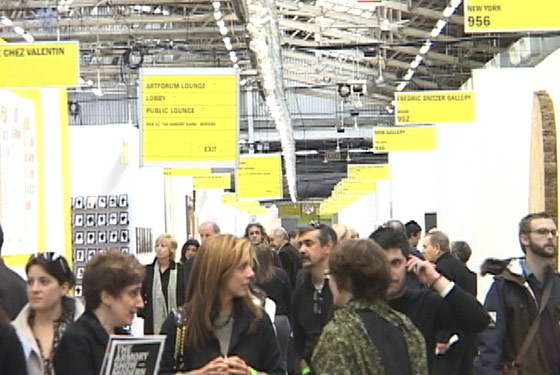
As the dust settles — or the paint fumes disperse — from Armory Week, the news is that sales were better than expected and the turnout at most of the fairs around town was tremendous, drawing nearly all of the city’s major collectors, curators, even unexpected art lovers like Morgan Freeman and Fran Drescher. But the real surprise is what sold: Nothing slick, nothing mirrored, nothing sparkly, not much photography. People bought art that was cheap (in this crowd, that means limited editions or pieces under $25,000) and art that looked homemade, handmade, self-conscious, or like an echo of childhood. Call it “Arts & Crafts Camp.”
San Diego artist Allison Schulnik’s paintings nailed the trend. She slathers paint like cupcake icing onto her own versions of bad genre paintings — clown portraits, flower vases, black-light tigers. So thick with oil you could smell the paint as you walked into the Pulse art fair, her work is both about painting and making fun of paintings. Art-world pied piper Charles Saatchi is a collector of her work. And at about $5,000 to $25,000, Santa Monica dealer Mark Moore sold so many of them at Pulse that she had to send more from her studio.
The Armory show itself was diminished this year by the pullout of some major participants from previous years, including Matthew Marks, one of the fair’s original founders. But the crowd was large and star-studded; sales were irregular, but expensive when they were made. Works by Anish Kapoor, Wassily Kandinsky and Paul McCarthy changed hands in excess of $200,000.
At the clubby Volta fair, one of the most popular booths was filled with colored yarn for a true “Arts & Crafts” vibe. Visitors rooted through knee-deep piles to find a few $500 gold necklaces placed there by Bangkok artist Surasi Kusolwong. He said his $30,000 installation was a reference to America’s California gold rush, an echo of the economy and was also just meant to draw people in. (It also featured a half-naked girl with yarn braids.) At another booth, artist Alejandro Diaz, the Public Art Fund artist who once decorated the Grand Concourse with giant canned foods, built a chicken coop of wire and wood and hung cardboard signs. One read: “In the future, everyone will be famous for $15.”
Pulse, a lighthearted, catch-as-catch-can mix of emerging artists, was big on installations, video art, and crafty work like American flags made of found objects. Also speaking to the relaxed vibe: Michael Scoggins “notebook scribbles” drawings. Freight + Volume sold a couple for $10,000 each. The most popular booth, at least for lounging, might have been cult Miami filmmaker Clifton Childree’s “MiaMuh Swamp Adventure,” a room-size rotting moviehouse showing Charlie Chaplin–style flicks. (We’re told it’s meant to be some comment on the Florida real-estate market.)
The biggest hit at Bridge, which featured booths from around the world, was a room-size installation by Hungarian artist Andrea Deszo. In something of a cross between a dollhouse and a theater set, the artist recreated a Romanian town with people, stores, a looming vampire, pastries or wedding dresses in the shop windows and, for some reason, bunnylike space creatures working underneath the sidewalk. Celebrating the twenty-year anniversary of the fall of communism, the piece is meant to comment on the carving up of Hungary after the World Wars.
Scope by Lincoln Center set a relaxed, stylish tone with an ersatz jazz coffeehouse/art gallery off the main sales floor and beanbag chairs in the video lounge. At the edge of the coffeehouse, there was a roomful of drawings where visitors were handed scissors and invited to snip one off the wall and leave a gift in return. In one inventive break with the norm, every sale of art in the coffeehouse split the proceeds with the artist 70–30, said fair director Alexis Hubshman. The usual dealer math is 50–50.




